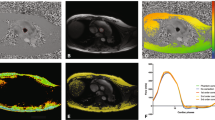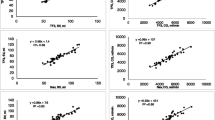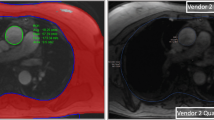Abstract
Background
Phase contrast magnetic resonance imaging (MRI) is a powerful tool for evaluating vessel blood flow. Inherent errors in acquisition, such as phase offset, eddy currents and gradient field effects, can cause significant inaccuracies in flow parameters. These errors can be rectified with the use of background correction software.
Objective
To evaluate the performance of an automated phase contrast MRI background phase correction method in children and young adults undergoing cardiac MR imaging.
Materials and methods
We conducted a retrospective review of patients undergoing routine clinical cardiac MRI including phase contrast MRI for flow quantification in the aorta (Ao) and main pulmonary artery (MPA). When phase contrast MRI of the right and left pulmonary arteries was also performed, these data were included. We excluded patients with known shunts and metallic implants causing visible MRI artifact and those with more than mild to moderate aortic or pulmonary stenosis. Phase contrast MRI of the Ao, mid MPA, proximal right pulmonary artery (RPA) and left pulmonary artery (LPA) using 2-D gradient echo Fast Low Angle SHot (FLASH) imaging was acquired during normal respiration with retrospective cardiac gating. Standard phase image reconstruction and the automatic spatially dependent background-phase-corrected reconstruction were performed on each phase contrast MRI dataset. Non-background-corrected and background-phase-corrected net flow, forward flow, regurgitant volume, regurgitant fraction, and vessel cardiac output were recorded for each vessel. We compared standard non-background-corrected and background-phase-corrected mean flow values for the Ao and MPA. The ratio of pulmonary to systemic blood flow (Qp:Qs) was calculated for the standard non-background and background-phase-corrected data and these values were compared to each other and for proximity to 1. In a subset of patients who also underwent phase contrast MRI of the MPA, RPA, and LPA a comparison was made between standard non-background-corrected and background-phase-corrected mean combined flow in the branch pulmonary arteries and MPA flow. All comparisons were performed using the Wilcoxon sign rank test (α = 0.05).
Results
Eighty-five children and young adults (mean age 14 years; range 10 days to 32 years) met the criteria for inclusion. Background-phase-corrected mean flow values for the Ao and MPA were significantly lower than those for non-background-corrected standard Ao (P = 0.0004) and MPA flow values (P < 0.0001), respectively. However, no significant difference was seen between the standard non-background (P = 0.295) or background-phase-corrected (P = 0.0653) mean Ao and MPA flow values. Neither the mean standard non-background-corrected (P = 0.408) nor the background-phase-corrected (P = 0.0684) Qp:Qs was significantly different from 1. However in the 27 patients with standard non-background-corrected data, the difference between the Ao and MPA flow values was greater than 10%. There were 19 patients with background-phase-corrected data in which the difference between the Ao and MPA flow values was greater than 10%. In the subset of 43 patients who underwent MPA and branch pulmonary artery phase contrast MRI, the sum of the standard non-background-corrected mean RPA and LPA flow values was significantly different from the standard non-background-corrected mean MPA flow (P = 0.0337). The sum of the background-phase-corrected mean RPA and LPA flow values was not significantly different from the background-phase-corrected mean MPA flow value (P = 0.1328), suggesting improvement in pulmonary artery flow calculations using background-phase-correction.
Conclusion
Our data suggest that background phase correction of phase contrast MRI data does not significantly change Qp:Qs quantification, and there are residual errors in expected Qp:Qs quantification despite background phase correction. However the use of background phase correction does improve quantification of MPA flow relative to combined RPA and LPA flow. Further work is needed to validate these findings in other patient populations, using other MRI units, and across vendors.



Similar content being viewed by others
References
Gatehouse PD, Rolf MP, Graves MJ et al (2010) Flow measurement by cardiovascular magnetic resonance: a multi-centre multi-vendor study of background phase offset errors that can compromise the accuracy of derived regurgitant or shunt flow measurements. J Cardiovasc Magn Reson 12:5
Lotz J, Meier C, Leppert A et al (2002) Cardiovascular flow measurement with phase-contrast MR imaging: basic facts and implementation. Radiographics 22:651–671
Srichai MB, Lim RP, Wong S et al (2009) Cardiovascular applications of phase-contrast MRI. AJR Am J Roentgenol 192:662–675
Caprihan A, Altobelli SA, Benitez-Read E (1990) Flow-velocity imaging from linear regression of phase images with techniques for reducing eddy-current effects. J Magn Reson 90:71–89
Chernobelsky A, Shubayev O, Comeau CR et al (2007) Baseline correction of phase contrast images improves quantification of blood flow in the great vessels. J Cardiovasc Magn Reson 9:681–685
Holland BJ, Printz BF, Lai WW (2010) Baseline correction of phase-contrast images in congenital cardiovascular magnetic resonance. J Cardiovasc Magn Reson 12:11
Lankhaar JW, Hofman MB, Marcus JT et al (2005) Correction of phase offset errors in main pulmonary artery flow quantification. J Magn Reson Imaging 22:73–79
Walker PG, Cranney GB, Scheidegger MB et al (1993) Semiautomated method for noise reduction and background phase error correction in MR phase velocity data. J Magn Reson Imaging 3:521–530
Bogren HG, Klipstein RH, Firmin DN et al (1989) Quantitation of antegrade and retrograde blood flow in the human aorta by magnetic resonance velocity mapping. Am Heart J 117:1214–1222
Powell AJ, Maier SE, Chung T et al (2000) Phase-velocity cine magnetic resonance imaging measurement of pulsatile blood flow in children and young adults: in vitro and in vivo validation. Pediatr Cardiol 21:104–110
Van den Hout RJ, Lamb HJ, van den Aardweg JG et al (2003) Real-time MR imaging of aortic flow: influence of breathing on left ventricular stroke volume in chronic obstructive pulmonary disease. Radiology 229:513–519
Conflicts of interest
We acknowledge that G. R. McNeal and A. Greiser are full-time employees of the Siemens corporation.
Author information
Authors and Affiliations
Corresponding author
Rights and permissions
About this article
Cite this article
Rigsby, C.K., Hilpipre, N., McNeal, G.R. et al. Analysis of an automated background correction method for cardiovascular MR phase contrast imaging in children and young adults. Pediatr Radiol 44, 265–273 (2014). https://doi.org/10.1007/s00247-013-2830-y
Received:
Revised:
Accepted:
Published:
Issue Date:
DOI: https://doi.org/10.1007/s00247-013-2830-y




